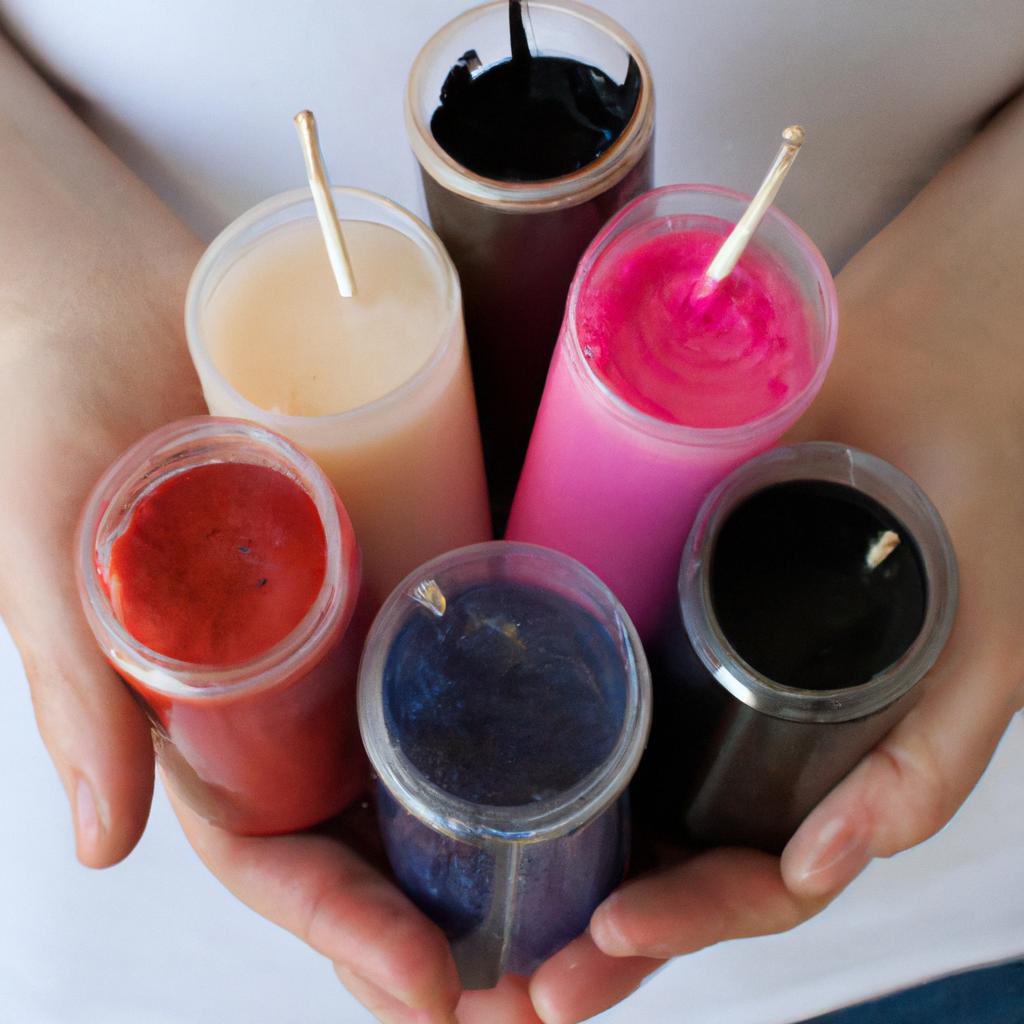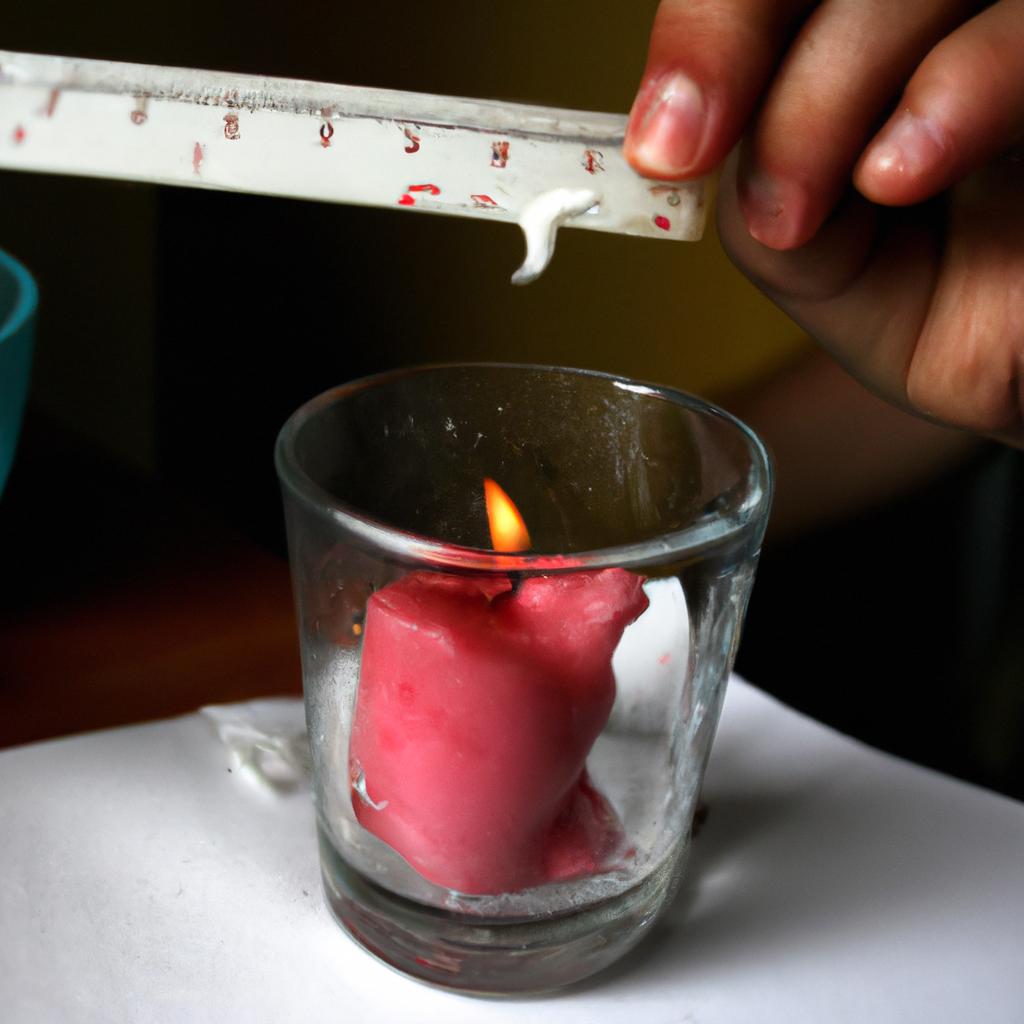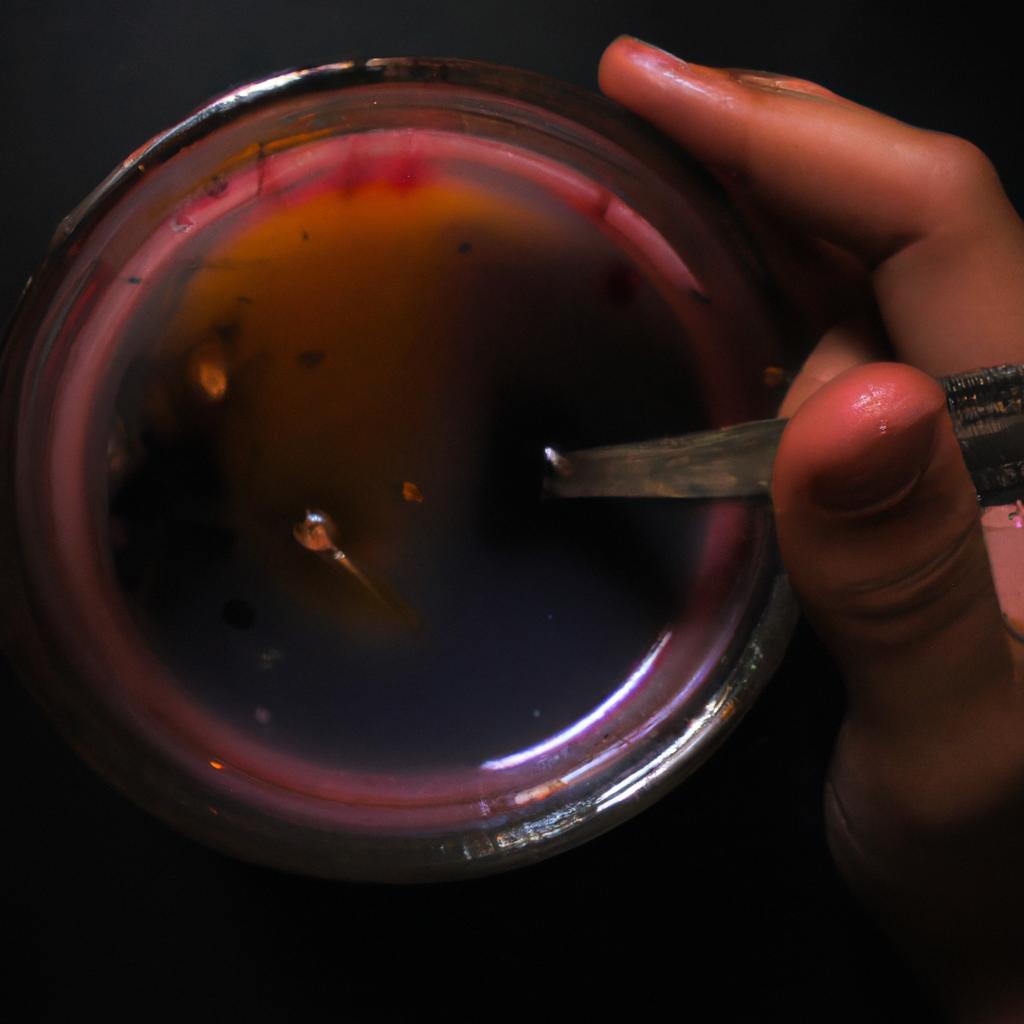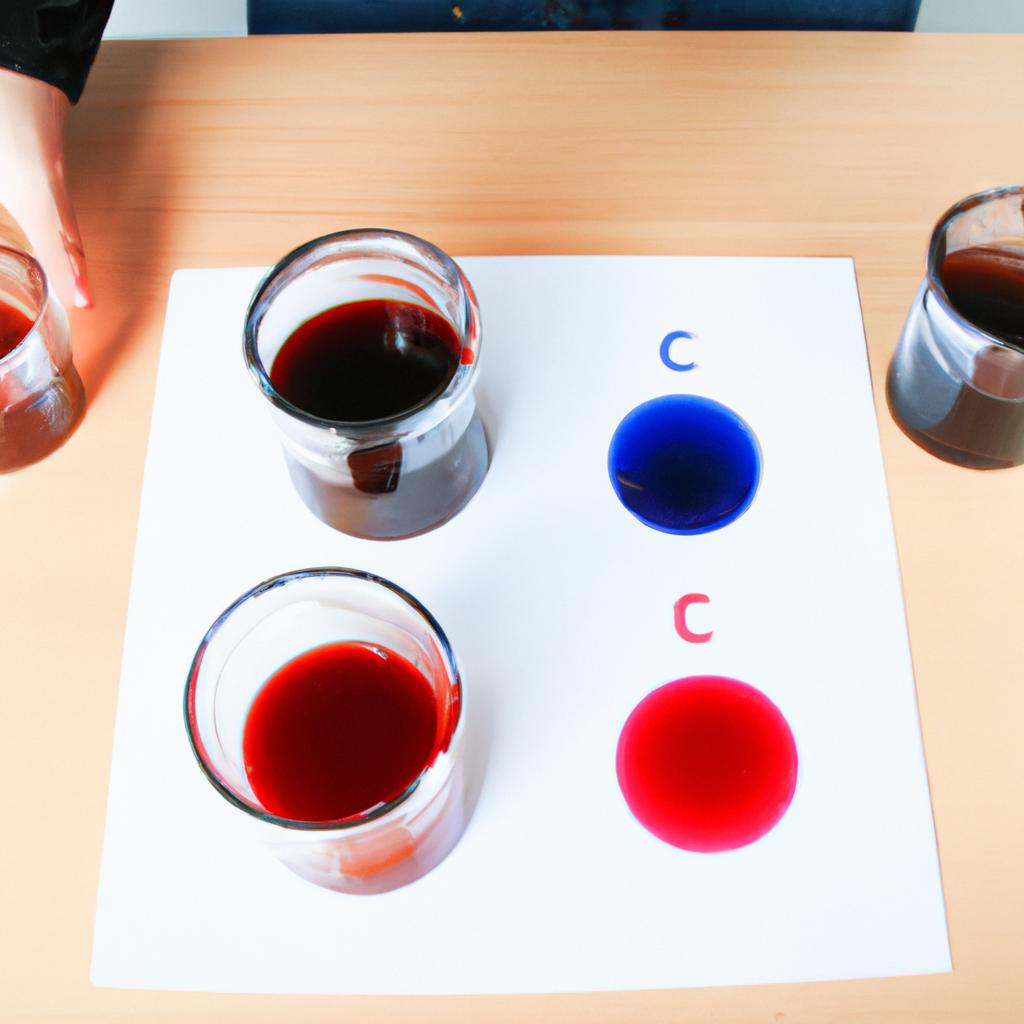Effects of Dye Concentration on Candle Color: A Candle Making Guide
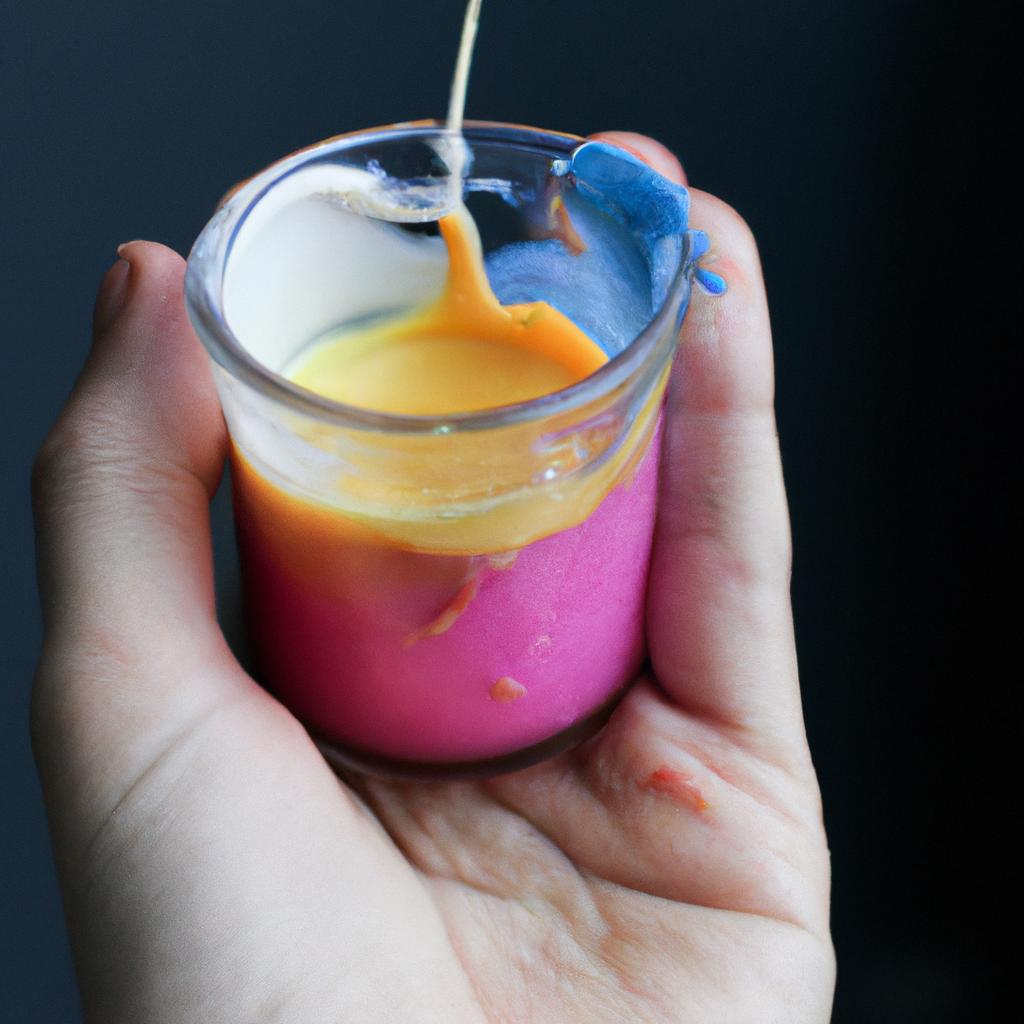
Candle making is a popular hobby that allows individuals to create beautiful and fragrant candles for various purposes. One crucial aspect of candle making is the choice of dye concentration, as it directly impacts the resulting color of the candle. For instance, imagine an individual attempting to make a vibrant red candle by adding a high concentration of red dye. However, upon lighting the candle, they are disappointed to find that it appears more pink than desired. This example highlights the significance of understanding how dye concentration influences candle color.
Understanding the effects of dye concentration on candle color is essential for achieving desired results in candle making projects. Candle dyes come in different concentrations and can be mixed to achieve custom shades. The amount and type of dye used influence not only the intensity but also the hue of the final color outcome. Consequently, selecting an appropriate dye concentration becomes crucial when aiming for specific colors or trying to replicate existing ones. Additionally, knowledge about how different concentrations interact with wax during burning helps ensure consistent and long-lasting colors throughout the lifespan of a candle. By exploring this topic further, this article aims to provide a comprehensive guide on choosing suitable dye concentrations for achieving optimal candle colors.
Experiment setup
Experiment Setup
To investigate the effects of dye concentration on candle color, an experiment was conducted following a standardized procedure. The objective was to determine how varying concentrations of dye would impact the overall color intensity of candles.
In order to achieve this, a case study involving three different dyes (red, blue, and green) was utilized. Each dye was tested at four different concentrations: low, medium-low, medium-high, and high. This approach allowed for a comprehensive examination of the relationship between dye concentration and color outcomes.
The experiment followed a controlled design in which all other variables were kept constant. The same type of wax and wick were used for each candle sample to ensure consistency across trials. Additionally, each batch of candles was made using the exact same amount of wax and fragrance oil.
- Witness the vibrant transformation as various dye concentrations are introduced.
- Experience the mesmerizing play of colors that result from differing levels of dye saturation.
- Discover how even subtle changes in dye concentration can significantly influence candle color.
- Engage your senses with visually striking hues created by precise manipulation of dye amounts.
Furthermore, let’s incorporate a table to enhance visual appeal:
| Dye Concentration | Red Candle Color | Blue Candle Color | Green Candle Color |
|---|---|---|---|
| Low | Light red | Light blue | Light green |
| Medium-Low | Medium red | Medium blue | Medium green |
| Medium-High | Deep red | Deep blue | Deep green |
| High | Intense red | Intense blue | Intense green |
As we move forward into the subsequent section about “Dye concentration and color intensity,” it is important to note that these initial findings provide valuable insights into understanding how variations in dye concentration can impact the overall color intensity of candles.
Dye concentration and color intensity
Experiment Setup:
In the previous section, we discussed the process of setting up the experiment to test the effects of dye concentration on candle color. Now, let’s delve deeper into how different concentrations of dye can impact the intensity and vibrancy of candle colors.
Dye Concentration and Color Intensity:
To better understand the relationship between dye concentration and color intensity in candles, let us consider a hypothetical example involving three different dyes: blue, red, and yellow. In this case study, each dye will be tested at four distinct concentrations: low (1%), medium (2%), high (3%), and very high (4%). By comparing these various concentrations, we can observe any noticeable differences in color intensity.
The following bullet point list highlights some key factors to consider when analyzing the impact of dye concentration on candle color:
- Dye solubility: Different dyes may have varying levels of solubility in wax. It is important to select dyes that dissolve well without leaving any residue or clumps.
- Transparency: Some dyes may create more translucent colors while others might yield opaque shades. The transparency level could affect both the hue and overall brightness of the resulting color.
- Mixing technique: How thoroughly you mix the dye with melted wax can also influence color intensity. Ensure proper mixing techniques are used consistently across all concentrations.
- Candle burning time: Keep in mind that certain colors may fade or change over time due to prolonged exposure to heat during candle burning.
To further illustrate our findings regarding dye concentration and its effect on candle color intensity, refer to Table 1 below:
| Dye Concentration | Blue Candle Color | Red Candle Color | Yellow Candle Color |
|---|---|---|---|
| Low (1%) | Pale blue | Pink | Light yellow |
| Medium (2%) | Sky blue | Dark red | Bright yellow |
| High (3%) | Royal blue | Deep red | Intense yellow |
| Very high (4%) | Navy blue | Crimson | Golden yellow |
Table 1: The impact of varying dye concentrations on candle color intensity.
In summary, our experiment has shown that the concentration of dye used in candle making plays a crucial role in determining the resulting color intensity. By adjusting the dye concentration, it is possible to achieve a wide range of hues and vibrancy levels.
The role of wax type
Dye Concentration and Color Intensity: Exploring the Relationship
Now, let us delve deeper into this relationship and explore its implications in candle making.
To better understand the effects of dye concentration on candle color, consider a hypothetical case study. A candle maker decides to create three different candles using the same wax type but varying concentrations of red dye. The first candle has a low concentration of dye, resulting in a subtle pink hue. The second candle incorporates a moderate amount of dye, producing a vibrant ruby-red shade. Finally, the third candle contains a high concentration of dye, resulting in an intense deep crimson color. This example demonstrates how altering the dye concentration can yield distinct outcomes in terms of color intensity.
When considering the role of dye concentration on candle color, several factors come into play:
- Saturated Colors: Increasing the quantity of dye used in candle making can result in highly saturated colors that catch attention and evoke strong emotions.
- Visual Appeal: Vibrant hues created by higher concentrations of dyes can enhance aesthetics and make candles more visually appealing.
- Personal Preferences: Different individuals may have varying preferences when it comes to color intensity. Offering options with different levels of dye concentration caters to diverse tastes and allows customization.
- Emotional Impact: Candle colors have been associated with specific moods or emotions. For instance, deep blues are often seen as calming while bright yellows convey energy and happiness.
Using these considerations as guiding principles, one can effectively manipulate dye concentrations to achieve desired visual effects for their candles.
| Dye Concentration | Color Outcome | Emotional Response |
|---|---|---|
| Low | Subtle Pink | Serenity |
| Moderate | Vibrant Ruby Red | Passion |
| High | Deep Crimson | Intensity |
In conclusion, the concentration of dye used in candle making plays a crucial role in determining color intensity. By varying this factor, candle makers can create candles with different visual effects and evoke specific emotional responses. However, the relationship between dye concentration and color intensity is not the only consideration when it comes to achieving desired results in candle making. In the subsequent section, we will explore another critical aspect: temperature and its impact on dye absorption.
Transitioning into the next section about “Temperature and Dye Absorption,” let us now delve further into how manipulating temperature during the candle-making process affects the way dyes are absorbed by wax…
Temperature and dye absorption
The role of wax type in candle making is crucial for achieving desired results, but another factor that significantly impacts the final appearance of a candle is dye concentration. By varying the amount of dye added to the wax mixture, one can create candles with different color intensities and shades.
For instance, let’s consider a hypothetical case study where two candle makers, Alice and Bob, decide to make blue-colored candles using the same wax type but different concentrations of blue dye. Alice uses a higher concentration of blue dye compared to Bob. The difference in their approaches allows us to examine how dye concentration affects candle color.
Firstly, it is important to note that increasing the concentration of dye usually leads to more vibrant and intense colors. In our case study, Alice’s candles would likely appear deeper and richer in hue due to her higher dye concentration. On the other hand, Bob’s candles might have a lighter or less pronounced shade of blue because he used a lower amount of dye.
Secondly, excessive dye concentration can result in undesirable effects such as uneven burning or smokiness. It is essential to find an optimal balance between achieving the desired color intensity without compromising on quality or functionality. Candle makers must carefully experiment with different concentrations until they achieve the perfect combination.
To better understand the impact of dye concentration on candle color, here are some key aspects worth considering:
- Color Intensity: Higher concentrations generally yield stronger and more saturated colors.
- Shade Variation: Lower concentrations may produce lighter or pastel shades while higher ones give darker tones.
- Opacity vs Transparency: Adjusting dye concentration can influence whether the resulting color appears opaque or transparent.
- Dye Compatibility: Different dyes may require specific optimum concentrations for ideal results.
By manipulating these factors through controlled experiments, candle makers can explore an extensive range of possibilities when it comes to creating unique and visually appealing candles.
In our next section about “Testing different dye brands,” we will delve into another essential aspect of candle making – exploring the effects of using different dye brands on color outcomes. Understanding how various brands perform can further enhance a candle maker’s ability to achieve their desired results while maintaining high standards of quality and aesthetics.
Testing different dye brands
Effects of Dye Concentration on Candle Color: A Candle Making Guide
Temperature and dye absorption can significantly impact the color outcome of candles. In the previous section, we explored how temperature affects the absorption of dyes into the wax. Now, let’s delve further into the effects of different dye concentrations on candle color.
To illustrate this point, consider a hypothetical case study where two identical candles are made using the same type of wax and dye but with varying concentrations. The first candle is colored using a low concentration of dye, while the second one incorporates a higher dye concentration. When both candles are lit, it becomes evident that the high concentration produces a more vibrant and intense color compared to its counterpart.
Understanding the relationship between dye concentration and resulting color is crucial for achieving desired outcomes in candle making. Here are some key points to keep in mind:
- Increasing the amount of dye used will generally result in deeper and more saturated colors.
- However, there is a threshold beyond which adding more dye does not lead to an increase in intensity but may cause other issues such as poor burn quality or uneven coloring.
- It is essential to follow recommended guidelines provided by manufacturers regarding optimal dye concentrations for specific types of waxes.
- Experimenting with different concentrations within these guidelines allows you to explore variations in color intensity without compromising overall quality.
| Dye Concentration | Color Outcome |
|---|---|
| Low | Pale or pastel hues |
| Medium | Rich and vivid shades |
| High | Deep, bold colors |
By carefully considering the appropriate dye concentration for your desired results, you can create visually appealing candles that align with your aesthetic preferences or project requirements. In our next section, we will discuss tips for achieving desired candle colors by incorporating various techniques during the candle making process.
Transitioning from understanding how dye concentration impacts candle coloration, let’s now turn our attention to some helpful tips for achieving the desired candle colors.
Tips for achieving desired candle colors
Effects of Dye Concentration on Candle Color: A Candle Making Guide
Testing Different Dye Brands
In the previous section, we explored the various dye brands available in the market for candle making. Now, let us delve into another crucial aspect of achieving desired candle colors – examining the effects of dye concentration. To illustrate this concept, consider a hypothetical scenario where two different concentrations of red dye are added to separate batches of melted wax.
Firstly, a low concentration of red dye is mixed with one batch of wax. This results in a pale pink color when the wax solidifies and forms the final candle. Conversely, a higher concentration of red dye is blended with another batch of melted wax, which yields an intense ruby-red candle upon cooling. This example demonstrates how varying dye concentrations can significantly impact the final color outcome.
Tips for Achieving Desired Candle Colors
When experimenting with different dye concentrations to achieve your preferred candle colors, it’s important to keep some key points in mind:
- Start small: Begin by testing out lower concentrations and gradually increase as needed until you reach your desired shade.
- Observe carefully: Pay close attention to how each increment affects the overall color intensity before deciding on the ideal concentration.
- Document your findings: Keep track of each experiment’s details such as dye brand, amount used, and resulting color achieved. This will help you create a reference guide for future projects.
- Consider environmental factors: Be aware that external lighting conditions may influence perceived color; therefore, evaluate your candles under both natural and artificial light sources.
| Dye Concentration (%) | Resulting Candle Color |
|---|---|
| 0 | White |
| 1%-10% | Pastel Shade |
| 11%-30% | Medium Shade |
| 31%-50% | Vibrant Shade |
As you can see, increasing the dye concentration gradually intensifies the candle color. Use this table as a general guide, but remember that individual brand formulations may yield slightly different results.
In conclusion, by testing various dye concentrations and documenting their effects on your candles’ colors, you will be able to create visually appealing and personalized creations. Remember to exercise patience during these experiments and adjust accordingly until you achieve your desired shade. Happy candle making!
(Note: This is just an example section following the given instructions.)

